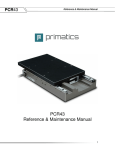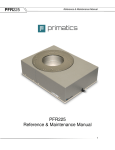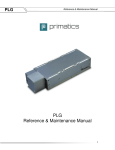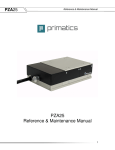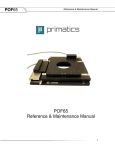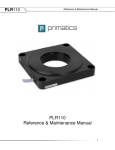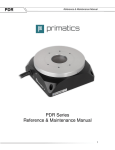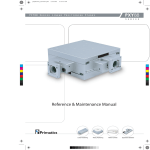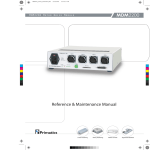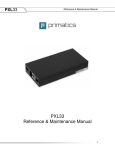Download POF115 Reference & Maintenance Manual
Transcript
POF115 Reference & Maintenance Manual POF115 Reference & Maintenance Manual 1 POF115 Reference & Maintenance Manual 32114 Mallard Ave. PO Box 409 Tangent, OR 97389-0409 U.S.A. Phone: Fax: Toll Free: Web: E-mail: [541] 791-9678 [541] 791-9410 [888] 754-3111 www.primatics.com [email protected] POF115 Manual Revision Information Publication Date July 2003 March 2003 April 2005 January 2007 January 2015 Notes Changed recommended grease from Lithium #2 to NSK Clean room grease Updated look & formatting Updated Ordering Info Updated Logo Notice: The descriptions, drawings, and specifications contained herein are subject to change. Primatics is not responsible for errors or omissions herein or for incidental damages in connection with the furnishing or use of this information. This document shall not be reproduced, photocopied, or duplicated, in whole or in part, without prior written approval of Primatics Corporation. For Specifications, Dimensioned Drawings and additional information, refer to the POF115 Datasheet available from our website at www.primatics.com. ©Copyright 2007-2015 by Primatics, Inc; All Rights Reserved. Primatics, the Primatics logo, PrimaFlex, PrimaSeal & SimpleMatch are trademarks of Primatics, Inc. 2 POF115 Reference & Maintenance Manual POF115 Manual Revision Information............................................................... 2 1) Overview .......................................................................................................... 4 2) Introduction – About the POF115 .................................................................. 5 3) Model Configuration ....................................................................................... 6 4) Personal Safety ................................................................................ 7 5) Conventions .................................................................................................... 8 5.1) Direction of Motion ............................................................................................................ 8 5.2) Units of Measure ............................................................................................................... 8 6) Installation Preparations ................................................................................ 9 6.1) Linear Motors .................................................................................................................... 9 6.2) Heat and Humidity........................................................................................................... 10 6.3) Contamination ................................................................................................................. 10 6.4) Electrical Noise ............................................................................................................... 10 7) Installation Procedures ................................................................................ 11 7.1) Tools you will need.......................................................................................................... 11 7.2) Unpacking ....................................................................................................................... 11 7.3) Mounting surface preparation ......................................................................................... 11 7.4) Mounting the POF115 ..................................................................................................... 12 7.5) Electrical Connections..................................................................................................... 12 7.5.1) Color Codes for Pigtailed Cable ................................................................................... 14 7.6) Hall Effect Commutation Sequence ................................................................................ 15 7.7) Home and Limit Sensors ................................................................................................. 15 7.7.1) Home Options: ............................................................................................................. 16 7.8) Limit and Home Switch Adjustment ................................................................................ 17 7.9) Recommended System Test ........................................................................................... 18 8) Preventive Maintenance ............................................................................... 18 8.1) Lubrication ....................................................................................................................... 18 8.2) Cables ............................................................................................................................. 19 9) Troubleshooting & Service .......................................................................... 19 9.1) Troubleshooting Help ...................................................................................................... 19 9.2) Service ............................................................................................................................ 19 3 POF115 Reference & Maintenance Manual 1) Overview This user guide is designed to help you install and maintain your POF115 Series linear positioning stage application. Follow these steps to ensure correct stage installation and maximum stage life: Step 1 Review this entire user manual. Become familiar with all installation procedures prior to integrating your system. Step 2 Review the safety summary to develop an understanding of standard safety practices when installing and operating automated equipment. Step 3 Familiarize yourself with the conventions summary. Step 4 Review installation procedures. For best results, follow these procedures carefully. Step 5 Once you successfully complete all the installation procedures, you will be ready to install and operate your stage. Step 6 Review preventive maintenance section for proper lubrication schedule. 4 POF115 Reference & Maintenance Manual 2) Introduction – About the POF115 The POF115 is a dual axis, large aperture positioning stage that provides accurate, flat motion. It provides high stiffness and load capacity. The open frame design gives the flexibility for access to the payload from both above and below. There are two drive configurations for the POF115. Each is briefly described in the table below. POF115 Single Drive POF115 Dual Drive Basic Width x Height (mm) 336 x 115 Travel Lengths (mm) 300 x 300 Drive Types Single Linear Motor Dual Linear Motor Encoder Option Linear Payload (kg) 50 75 Each can be configured with options listed in Section 3. Many customers choose the Primatics Motion Drive Chassis (MDC) to power POF115 stages. The MDC is a modular system that packages motor drivers, encoder interfaces, power supplies and safety systems into a single chassis. It acts as an intermediary between a Galil Optima, National Instruments 7344 or Delta Tau PMAC II motion control cards and a Primatics positioning stage. Pre-wired high-flex cables are available to allow a convenient connection from the stage to the MDC chassis. The MDC drive chassis rd interfaces 3 party controllers via a removable interconnect module. These interconnect modules conform to each manufacturers interconnect cable, and internally route all the command and I/O signals. Optionally, a Primatics positioning stage can be used with many third party controller and amplifier systems. In this case, a pigtailed cable is available to simplify the connection between the POF stage and controls. 5 POF115 Reference & Maintenance Manual 3) Model Configuration 6 POF115 Reference & Maintenance Manual 4) Personal Safety Please review before installing your positioning stage Observe common industrial safety practices when installing and operating automated equipment. o Have power connections made by qualified personnel. o Keep fingers and other items out of any opening in the stage while it is in operation since injury or damage may result. o Provide a safe access route and adequate room for servicing. o Perform the recommended periodic maintenance described in this document. o Verify that the work envelope is free of obstructions before the positioning stage is powered. o Insure that you have the feedback wired properly to the controller before applying power to the positioning stage. Improper feedback connections can cause a motor run-away condition that has the potential to damage the stage and injure an operator. o Only trained operators of the positioning stage should be allowed near the work environment. o If so equipped, identify emergency stop circuits and actuators in the workcell. o Note the places in the workcell where pinch points occur, and provide adequate safety clearance or safety curtain. o Never operate the motor in a location that could be splashed by water, exposed to corrosive or flammable gases or is near combustible substances since this may cause an electric shock, fire or malfunction. o Never touch the motor, driver, or peripheral devices when the power is on or immediately after the power is turned off. The high temperature of these parts may cause burns. 7 POF115 Reference & Maintenance Manual 5) Conventions 5.1) Direction of Motion The positive direction of motion for both axes is defined as shown in Figure 5-1. A positive direction of motion also signifies the encoder count is increasing. The forward limit switches are encountered just before the end of travel in the forward direction. The reverse limit operates similarly in the reverse direction. Figure 5-1: Positive direction convention 5.2) Units of Measure Primatics uses the metric system for all specifications and dimensions. All linear dimensions are specified in millimeters. Accuracy, repeatability, resolution, flatness and straightness for the POF is specified in microns. Load capacity is specified in kilograms and moment capacity is given in Newton-meters. All torque specifications are given in Newton-meters. Thrust specifications are given in Newtons. The following table gives some common conversions into English units: Metric Unit English Unit 1 Kilogram equals 0.0685 slug* 1 micron equals 0.0000394 inch 1 millimeter equals 0.0394 inch 1 Newton-meter equals 8.85 in-lbs 1 Newton equals 0.2248 lbs 2 *1 Kg has a weight of 2.205 lb when g = 9.8 m / s 8 POF115 Reference & Maintenance Manual 6) Installation Preparations This section outlines installation environments. Unfavorable installation conditions may cause electric shock, fire, or breakdown. Certain breakdown situations or malfunctions in particular may lead to serious injury or other consequences. Assure that the unit is used under the following installation conditions: o o o o o o Indoors, free from being splashed by water No corrosive or inflammable gases present Well ventilated place, minimum level of dust or waste An environmental temperature range between 0-40°C, and humidity between 2080% RH (location with no condensation) Note - These values show the range in which operation can be carried out safely, but not the environmental range in which stages accuracy can be guaranteed. Stage accuracy can be guaranteed at 20°C +/- 1°C. Location should not be affected by electrical noise. Location should be where inspection and cleaning can be performed without difficulty. 6.1) Linear Motors Linear motors have large magnetic flux that can draw ferrous metals inside them from large distances, destroy magnetic media, and disrupt some electronic circuits. Materials attracted to the magnets can pinch fingers and cause injury. Great care must be taken when operating less than 25mm from the surface of the motor. In addition, braking is difficult for linear motors making them inappropriate for many vertical applications. Make sure no load is attached to the linear motor stage when stage is first connected to the electronics. Linear motors can generate large accelerations and improper wiring to the control system can result in a high-speed crash. 9 POF115 Reference & Maintenance Manual 6.2) Heat and Humidity All positioning stages are assembled and tested at 20°C. Any stage calibrations are also performed at 20°C. For optimum accuracy the ambient temperature should be maintained at 20°C. Deviations from this nominal temperature may result in degraded accuracy performance. Large thermal gradients in the interior of the stage can result from motor heat created by high acceleration moves. Care must be taken to limit the duty cycle of the linear motor to maintain stage performance. Airflow across the motor will help minimize thermal expansion effects and increase the allowable duty cycle. 6.3) Contamination Applications in dirty or dusty environments require the electrical, optical and mechanical components to be protected. The POF115 series is intended for clean environments free from small particulates and fluids. 6.4) Electrical Noise Electrical noise is the corruption of signals carried over low voltage wires. Encoder signals can be corrupted resulting in spurious encoder counts thus causing the stage to drift. Grounding, shielding, and spatial separation are all countermeasures to reduce the influences of electrical noise on performance. You can minimize the potential for electrical noise by observing the following installation precautions: o o o Physically separate low voltage conductors from those carrying high voltage. Ensure that all components are properly grounded. Ensure that all wiring is properly shielded. 10 POF115 Reference & Maintenance Manual 7) Installation Procedures 7.1) Tools you will need The POF linear positioning stage uses M8x16mm sockethead cap screws for the base plate mounting. The carriage plate has M6 tapped holes for customer mounting. 7.2) Unpacking Carefully remove the stage from its shipping crate and inspect it for evidence of shipping damage. Report any damage immediately to your authorized dealer. If so equipped, remove the red shipping clamp from the stage. Improper handling of the stage may degrade its performance. Follow these guidelines when handling and mounting your stage. 1) Do not drop the stage onto its mounting surface. Place the stage gently on the mounting surface. Impact loads can cause high spots on mounting surfaces, misalignment of drive components and warping of the base. 2) Do not drill holes into the stage. If additional holes are necessary, contact your local distributor. 3) Lift the stage by its base structure only. Do not lift by the motor drive assembly. 4) Stage disassembly and alteration, unless specified otherwise, may void warranty. 7.3) Mounting surface preparation The characteristics of the surface the positioning stage is mounted to will have a large effect on system performance. An accurate and flat positioning stage will conform to the shape of its mounting surface, therefore a flat mounting surface is required. The flatness and straightness specifications can be affected under large loads. For best results in maintaining stage specifications we suggest the following: 1) Use a laboratory Grade AA granite surface plate 2) Before mounting stage, inspect for burrs or dings on the stage mounting surfaces 3) Clean all mounting surfaces with acetone In the absence of a granite surface plate, we recommend a base plate made of the same material as the base of the stage. A mounting surface constructed out of a material different from the stage base material can introduce warping in the stage in the presence of a thermal gradient. The surface flatness should match the requirements of the application; a good starting point is to have the mounting surface flat to less than 5-8µm. 11 POF115 Reference & Maintenance Manual 7.4) Mounting the POF115 The POF115 has four mounting holes that can be accessed by moving the X-Axis to its forward and reverse limits. Figure 7-1 shows the location of these mounting holes. Figure 7-1: Mounting Hole Locations 7.5) Electrical Connections Electrical connections to the stages depend on the type of stage in use. All POF115s are terminated with a 450mm flexible cable with a 28 position circular connector on the end. The pin-out of this connector is shown with Table 7-1. This particular configuration is optimized for use with Primatics MDC drive chassis via an extension cable. Connections to other drives and controls are also made through this connector. A popular option for applications not using the Primatics MDC drive chassis is the pigtailed extension cable. This is similar to the extension cable used to connect a stage to the MDC drive chassis, except the end that connects to the motor drive and controller is un-terminated. Section 7.7.1 shows the conductor assignments for this cable. 12 POF115 Reference & Maintenance Manual Table 7-1: Axis Connector (Motor, encoder, limits, home, temp) FCI circular connector, 28 pins, size 20 shell Pin A B C D E F G H J K L M N P R S T U V W X Y Z A B C D e Function Motor A Motor B Motor C Motor Shield Encoder 5V – power for encoder Encoder A+ output Encoder A- output Encoder B+ output Encoder B- output Encoder Shield 12VDC - for limit, home, and temp sensor DCCOM Home – Switch to DCCOM when on forward side of home position Not used Not used Chassis Hall V+ Hall VEncoder Common Encoder Index + Encoder Index Forward Limit Switch – switch to DCCOM in normal operation Reverse Limit Switch – switch to DCCOM in normal operation Signal Shield Hall A Hall B Temperature monitor – connect to DC Common for temperature OK Hall C 13 POF115 Reference & Maintenance Manual 7.5.1) Color Codes for Pigtailed Cable Cable consists of 3 independent shielded “pods”: One for motor signals, one for encoder rd signals & a 3 for sensors. Each of the pods is described below. Cable 1 █ █ □ █ Color Black Red White Shld Function Motor A Motor B Motor C Motor Shield Cable 2 █ □ █ █ █ █ █ █ █ Color Red White Yellow Green Blue Shld Black Orange Brown Function Encoder 5V Encoder A+ output Encoder A- output Encoder B+ output Encoder B- output Encoder Shield Encoder Common Encoder Index + Encoder Index - Cable 3 █ █ □ □/█ □/█ █ █ █ █ █ █ █ █ █ Color Green Blue White Wht/Red Wht/Black Shld Black Brown Violet Gray Red Orange Tan Yellow Function 12VDC DCCOM Home Not used Not used Chassis Hall V+ Hall VForward Limit Switch Reverse Limit Switch Hall A Hall B Temperature Monitor Hall C 14 POF115 Reference & Maintenance Manual 7.6) Hall Effect Commutation Sequence The following diagram shows the motor signal timing for the Servo Motor option Figure 7-2: Motor commutation chart The following diagram shows the encoder signal timing for the Encoder option Figure 7-3: Timing diagram for the encoder signals 7.7) Home and Limit Sensors Each POF115 stage includes Forward and Reverse Limit sensors and a Home sensor. Figure 7-4 shows the equivalent schematic for these switches. 15 POF115 Reference & Maintenance Manual Figure 7-4: Equivalent Limit, Home, and Temp circuit schematic 7.7.1) Home Options: The Home switch is ordered in either the Normally Closed (H1) or Normally Open (H2) configuration H1: Switch is closed when carriage is between the negative (reverse) end of travel and the home transition point. It is open from the transition point to forward end of travel. H2: Switch is open when carriage is between the negative (reverse) end of travel and the home transition point. It is closed from the transition point to forward end of travel. 7.7.2) Limit Options: The Limit switches are ordered in either the Normally Closed (L1) or Normally Open (L2) configuration L1: When the carriage is in the normal operating range of travel, both limit switches are closed. When the carriage encounters a limit the switch opens. The switch will close again when the carriage is moved away from the switch. L2: When the carriage is in the normal operating range of travel, both limit switches are open. When the carriage encounters a limit the switch closes. The switch will open again when the carriage is moved away from the switch. 16 POF115 Reference & Maintenance Manual 7.8) Limit and Home Switch Adjustment The limit and home switch positions are preset at the factory. The limits are nominally set to yield slightly more travel than specified in the model configuration. The nominal home switch transition point is about 2mm to the positive side of the center of travel. Figure 7-5: Limit and Home Sensor Transition Ranges The home and limit signals are each produced by separate reflective sensors mounted to the underside of the carriage. A white reflective strip (the home vane) mounted to the base runs the length of the stage and is viewed by each sensor. A special non-reflective black tape is applied to the home vane. Each switch is closed when viewing the white area and is open when viewing the non-reflective tape. Figure 7-6A shows the tape configuration for the normally closed sensor options (H1, L1). Figure 7-6B shows the tape configuration for the normally open sensor options (H2, L2). Limited adjustments can be made to the limit transition signals by adding or removing black tape. Figure 7-6A: Home Vane Configuration H1, L1 Options (Normally Closed) Figure 7-6B: Home Vane Configuration H2, L2 Options (Normally Open) 17 POF115 Reference & Maintenance Manual 7.9) Recommended System Test Before attaching a load or applying power to your stage, verify the encoder and limit switches are working properly. Move the stage carriage by hand in the positive direction and verify the encoder count is increasing. Runaway conditions caused by miswired encoders can result in stage damage and personal injury. Move the carriage to each end of travel to ensure limit switches are working properly. When closing the position loop for the first time, set the torque limit of your controller to a low value and use conservative tuning gains. Once the control loop is working properly, payloads can be added to the stage carriage. 8) Preventive Maintenance Performing preventive maintenance procedures on your stage will extend its life and improve its long-term performance. 8.1) Lubrication Use clean room grease to lubricate the linear guide components. We recommend NSK grease part #GRS LG2. For low duty cycle applications, it is recommended that linear guides are re-greased every six months. High duty cycle applications may require more frequent re-lubrication. Lubrication intervals depend on duty cycle, load and ambient conditions. The linear motor is a non-contact device and requires no lubrication. Primatics offers a grease kit that has all the necessary hardware to re-lubricate the linear bearings. Grease ports are located on the ends of the linear guide blocks along the axis of the rails. Use a grease gun with the appropriate fitting to connect to the grease port. Figure 8-1: Bearing block lubrication fitting 18 POF115 Reference & Maintenance Manual 8.2) Cables The flat cables inside the stage are designed for millions of cycles of use. The pigtail cables exiting the stage are strain relieved but excessive force or repetitive cycling forces should not be applied to the pigtail cables. 9) Troubleshooting & Service 9.1) Troubleshooting Help For further assistance contact the factory: M-F 8AM to 5PM Pacific Time Phone: Fax: Toll Free: Web: E-mail: [541] 791-9678 [541] 791-9410 [888] 754-3111 www.primatics.com [email protected] 9.2) Service Should your device require factory service, contact the factory for a Return Materials Authorization (RMA). When inquiring about an RMA please have the following information available: o Your contact information (name, phone, email, address) o Unit Serial Number (see Figure 9-1) o Symptom of problem o History of troubleshooting steps already taken Figure 9-1: POF115 Serial Number Location(s) 19



















